Birds of the same feather
Boeing’s family of unmanned aerial
vehicles is being designed to satisfy the needs of a multi-billion dollar
market.
BY DARYL STEPHENSON

So goes the family, so goes the business.
That’s Boeing’s approach to the burgeoning UAV market;
to offer a “family” of unmanned, net-enabled systems that employ the best possible
capabilities from across the company
and strategic partners. Boeing’s goal: Have its customers view the company as
a solutions provider for every enduring need.
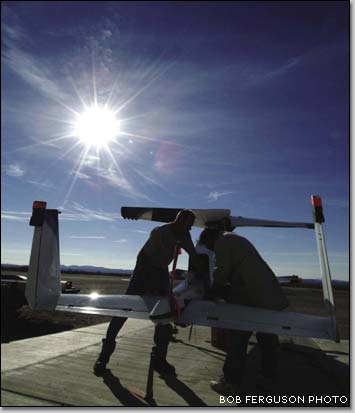
Canard Rotor/Wing (X-50 Dragonfly) Under joint development by Phantom Works and the U.S. Defense
Advanced Research Projects Agency, the Canard Rotor/Wing is a revolutionary
aircraft that combines the speed and range of a jet-powered fixed-wing
aircraft with the flexibility of rotary-wing flight. The vehicle’s
rotor is designed not only to spin and provide lift during vertical
takeoffs and landings but also to stop turning during flight, lock
in place laterally, and function as a wing for high-speed cruise.
The Dragonfly demonstrator, also known as the X-50A, is propelled
by a conventional turbofan engine combined with a unique Boeing
reaction drive rotor system. During rotary-wing flight the engine
powers the rotor system using thrust ducted to nozzles near the
rotor tips. During conversion, a canard wing and horizontal tail
provide the lift necessary to remain aloft until the rotor blade
stops and functions as a fixed wing. Engine power is redirected
aft to provide forward thrust. The aircraft requires no gearbox,
transmission or tail rotor.
The vehicle is 17.7 feet (5.4 meters) long, 6.5 feet (2 meters)
high and weighs 1,480 pounds (662 kilograms).
The first CR/W technology demonstrator completed two successful
hovering flight tests in late 2003, for 20 and 80 seconds at 12
to 14 feet (3.7 to 4.3 meters) above the ground. The second demonstrator
began ground checkout tests in April and is scheduled to begin
flight testing soon.
Enhanced Canard Rotor/Wing platforms are projected to be available
for service in the 2012 timeframe. |
The Boeing family of UAVs under development includes fast, lethal,
highly sophisticated integrated systems built specifically for combat,
like the X-45C Joint Unmanned Combat Air Vehicle; long-endurance, surveillance
and reconnaissance systems like the A160 Hummingbird; and small tactical
UAVs produced with partners, such as the ScanEagle.
And even if these UAVs differ in size, design, missions or unique
technologies, Boeing is working to link them through common mission-management
software that lets them operate effectively in the same network.
That’s a key component of the Boeing approach to UAVs, says Kim Michel,
Boeing Phantom Works director of Advanced Unmanned Systems.
The Boeing family of UAVs is really about the whole system—the vehicle,
ground control station, human systems interface
and mission management,” Michel says. “We are working on software that will do
mission management, mission planning, sensor planning, communications planning
and the vehicle’s visibility to the operator. The software we’re writing is actually
common across all of our platforms. We just have to modify it for individual
interfaces to individual platforms.”
Such an approach is attractive to the U.S. Department of Defense because
of its applications to network-centric operations and joint operations
between services and with allied coalition forces, Michel says.
“What we’re doing with our mission management software is creating
an open, nonproprietary system in which one station or set of hardware
can control multiple vehicles, multiple types of vehicles and then
get the information that is sent down from those vehicles displayed
on common displays,” Michel says. “Then you can overlay a kind of big
picture view of what’s in the area based on what all your surveillance
platforms are telling
you.”
The development of mission management software for UAVs is part of
a wider Boeing effort to “meet the total information needs of the customer,” Michel
says. “Our customers expect to be able to procure, own, operate and
maintain unmanned vehicles at much lower costs than they have seen
on manned platforms. A ground commander needs immediate situational
awareness as well as theater-level information. He can generate a tremendous
amount of information with a lot of UAVs flying around. How does he
do that affordably and deconflict the airspace with other manned and
unmanned platforms?”
The UAV market is growing, and so is Boeing’s presence in it, Michel
says. Four years ago, U.S. government spending on UAVs was in the range
of $200 million to $300 million a year. Now, that’s up to several billion
dollars annually. UAVs, including the Boeing ScanEagle, have been deployed
and used successfully
in U.S. combat operations in Iraq and Afghanistan.
“It’s really caught the eye of the Department of Defense and they’re
finding that the more they use these kinds of systems, the more uses
they find for them,” Michel says.
Phantom Works is doing most of the heavy lifting in early development
of Boeing UAVs.
After reaching a certain point in their development, these programs
are transitioned to Boeing Integrated Defense Systems. The X-45 became
part of IDS in January 2004.
Summaries of each of these programs appear over the next few pages.
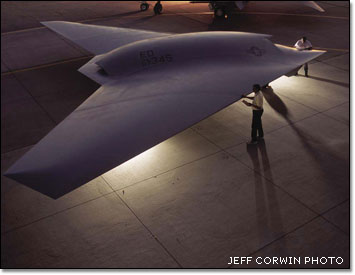 X-45C
Joint Unmanned Combat Air Systems X-45C
Joint Unmanned Combat Air Systems
The Boeing X-45C Joint Unmanned Combat Air Systems is the first
unmanned system specifically designed for combat operations. It
will significantly increase the warfighter’s effectiveness in missions
such as persistent strike; penetrating electronic attack; suppression
of enemy air defenses; and intelligence, surveillance and reconnaissance.
The X-45A demonstrator for the J-UCAS made its first flight in
May 2002. Since then, the program includes the following among
many accomplishments:
• An X-45A demonstrator in April 2004 hit
a ground target with a 250-pound inert near-precision-guided weapon
released from its internal weapons bay.
• By flying two X-45As together
in August 2004, the program demonstrated multi-vehicle operations.
• In
February, the X-45A conducted its first simulated combat mission.
While the X-45A undergoes flight testing, Boeing Integrated Defense
Systems is developing an advanced, larger version, the X-45C, for
an early capabilities demonstration. The C configuration will be
approximately 39 feet long with a 49-foot wingspan (11.9 meters
and 14.9 meters, respectively), and cruise at 0.80 Mach. The first
X-45C will be completed in 2006 and flown in a U.S. government
operational assessment beginning in 2007.
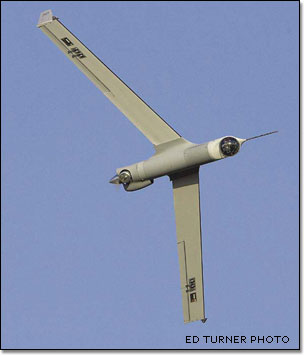 ScanEagle ScanEagle
The
ScanEagle is a low-cost, long-endurance autonomous UAV developed
by Boeing Phantom Works and The Insitu Group of Bingen, Wash. ScanEagle
is based on Insitu’s miniature robotic aircraft and draws on Boeing
systems integration, communications and payload technologies.
Boeing
foresees customers using ScanEagle vehicles to loiter over trouble
spots and provide intelligence, surveillance and reconnaissance
(ISR), or function as a communications relay platform. Since
being deployed in Iraq last summer, ScanEagle has surpassed 2,800
flight
hours during operational missions. The U.S. Marines have relied
heavily on the system and its long-endurance capability, ISR
value and ability to operate in harsh weather.
Capable of flying above
16,000 feet (4,880 meters), the ScanEagle has also shown the
ability to provide persistent low-altitude reconnaissance.
Boeing received
a $14.5 million contract from the U.S. Navy in April to provide
UAVs for Naval Expeditionary Strike Group and oil platform security
in the Persian Gulf.
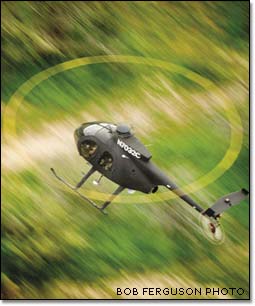 Unmanned
Little Bird Unmanned
Little Bird
The Unmanned Little Bird, a modified MD 530F helicopter,
is designed for both manned and unmanned missions. It can fly
a wide variety of missions, from cargo resupply to long-endurance
intelligence, surveillance
and reconnaissance. It can also be configured to carry a variety
of payloads and to launch weapons in combat. This range of missions
sets it apart from other UAVs.
Boeing and the U.S. Army Aviation
Applied Technology Directorate have begun a joint $1.6 million
Unmanned Little Bird weapons testing program. Firing tests
are scheduled to start in June or July, says Dino Cerchie,
Boeing Phantom Works program manager for the Unmanned Little
Bird.
ULB flight tests, with a safety pilot in the cockpit, began
last fall
at Mesa, Ariz. By April, the single flight-test vehicle had
accumulated more than 150 hours of flight. Later this year, the
ULB will
begin unmanned flight tests. The ULB team includes Boeing and
L-3 Communications.
A160
Hummingbird
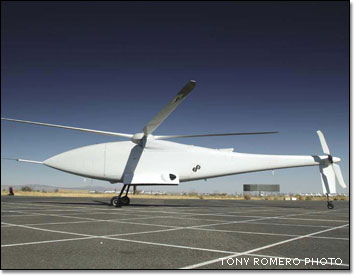 The A160 Hummingbird UAV looks like a helicopter but
is unlike any other helicopter. It can reach higher altitudes,
hover for longer periods of time, go greater distances and operate
much more quietly than current rotorcraft. With its unique optimum-speed
rotor technology, the Hummingbird adjusts rotor RPM to optimize
performance at different altitudes and cruise speeds. The A160 Hummingbird UAV looks like a helicopter but
is unlike any other helicopter. It can reach higher altitudes,
hover for longer periods of time, go greater distances and operate
much more quietly than current rotorcraft. With its unique optimum-speed
rotor technology, the Hummingbird adjusts rotor RPM to optimize
performance at different altitudes and cruise speeds.
The aircraft
addresses current and emerging requirements of the U.S. armed
forces, the U.S. Department of Homeland Security, and international
military
and security organizations. Missions for the A160 include reconnaissance,
surveillance, target acquisition, communications relay and precision
resupply.
A Phantom Works IDeAS team called Advanced Unmanned Systems–Concept
Exploration is developing the A160 with the government. The Hummingbird
is designed to fly 2,500 nautical miles (4,630 kilometers) with
endurance in excess of 24 hours and a payload of more than 300
pounds (136 kilograms). It is intended to fly at an estimated top
speed of 140 knots (259 kilometers per hour) at ceilings above
15,000 feet (9,100 meters). Through mid-April 2005, three A160s
had completed 27 test flights for 34 hours of flight time. |
|

